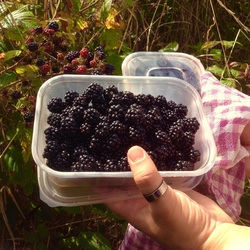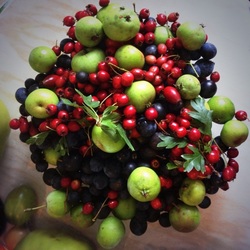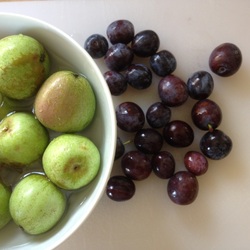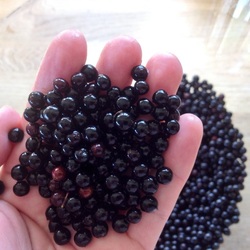|
|

30 Days Wild card designs featuring my sketches.
|

|
The sights and sounds of summer . . .
To start, why not put some sounds in your ears while you read over this post? Below is a compilation of various recordings I made (on my camera, so not brilliant quality) during June. Originally, I intended to do a recording every day for 30 Days Wild, but didn't manage it. Speaking of 30 Days Wild, it was fantastic to get my pack from the Wildlife Trusts, featuring cards with pictures that I drew! It was very exciting to have my art going out to thousands of people. I talked about the process of creating the cards here.
So, back to our activites in June. We paid a visit to London for a family wedding at the start of the month and enjoyed some green spaces in the city.
The wedding cakes were a sight to behold. All the fruit and flowers inspired me to try something I'd been meaning to get around to for the last few years: cooking with elderflowers. I foraged a couple of flower heads and made them into pikelets (sweet little pancakes), which worked quite nicely.
It's hard to fit in outdoors time around a full time job with a 1-2 hour commute each way, so we decided to start a little tradition of going on a walk on the way home at least once a week. We chose Arlington Reservoir, because it's a one hour circular walk on an easy trail, with a variety of stuff to look at: the water and waterbirds, a bit of woodland, views of the South Downs, animals, buildings, fields. It was satisfying to watch the evolution of the micro-ecosystem that is the reservoir wall over the course of the summer and autumn, until it got too dark to walk any more.
There was a gorgeous Chicken of the Woods fungus growing on Battle High Street, of all places. I didn't want to take it, as it looked so lovely and colourful. Somebody else didn't have any such qualms - it had been cut down when we next went past, a couple of days after I took this photo. (I later heard it was a friend of a neighbour, who presented it to a family member for their birthday!)
We had an amazing microadventure on the South Downs with probably the most beautiful scenery I saw this year. The HRRA walk this month was also on the South Downs, which meant even more fabulous views!

Small tortoiseshell butterflies, which have suffered a population decline, especially in the south of the UK.
And at the end of the month we went Champing for the first time. Despite quite a grey and drizzly month overall, we did manage to make the most of it.
3 Comments
Do you like food? How about cycling and/or camping? Are you a woman, a feminist, a queer person and/or a vegan? Do you like women, queers and/or vegan food? Then I suggest you get your hands on these two zines. Content note: There is a GIF at the bottom of this post. 3rd Gear is a bike zine by women and queers, which explicitly aims to give a platform to voices not usually heard from in cycling magazines (which, let’s face it, are usually aimed squarely at people with most of the privileges). The zine is edited by Danni, who some of you might remember from her bike touring microadventures last year (September, December). Issue #2 features reflections, articles, art, bike shed updates and advice on topics including electric bikes and mental health (“Is that a cheat’s bike?” by Esther Johnson), the politics of cycling (“War on our roads: Entitlement, cycling and victim blaming” by Danielle Madeley), cycling as a trans person (“Transcyle” by Bobbi Jane), contributions from the folks of No Award, plus more! Tofu and Trangias is a spin-off, also edited by Danni. It’s a vegan camping and bike touring cookzine divided in two sections - the first about pre-preparing foods to take with you, the second focussing on preparing and cooking when you’re out and about. It has recipes for cookies, spice mixes, curries, vegan sausage rolls, salads and more. As it’s an Australian zine, it’s biased towards Australian considerations (climate, ingredients, availability of water), but it’s definitely translatable to other places. I have a recipe in Tofu and Trangias, so obviously it’s a top quality publication. I thought I’d share my recipe here, to give you a taste (haha, get it?) of the kind of thing you might find in the zine. You can get your own copy of both zines from the Wrenchworthy store. Recipe: Energy BallsThese tasty little treats have got me through many a mid-afternoon slump on long walks. They work a bit like scroggin, only you don’t end up having to eat the dregs made up of the crap nuts/seeds/fruit that you don’t like. Energy Balls (or Energy Truffles, if you are feeling fancy) are super easy to make and very forgiving if you want to experiment with ingredients and flavourings. They also keep pretty well without refrigeration, although the chocolate can melt if you’re out in hot weather . . . and there is the temptation to shove them all in your mouth at once. Ingredients
Method
We've been off travelling for the last couple of weeks, doing a Channel to Channel walk across Devon and Somerset, then a canoeing trip down the River Wye. I'll try to get a post up next week with photos of those delightful places! April's Outdoor Bloggers theme was "from your own front door", a challenge to explore the world within a mile of your house. As you might remember, Lake Field is just around the corner from me - and not only does it have a lovely view, it also contains one of my favourite springtime foraging herbs: sorrel. Sorrel is easy to pick in decent quantities, great to eat fresh in sandwiches and salads and delicious in soup or risotto. Spring has truly arrived (this week the weather has been turning on a penny from snow showers to bright blue skies) and we're in the middle of the first foraging glut of the year. This month I've seen loads of wild garlic, primroses, stinging nettles, dead nettles, Alexanders, Jack-by-the-hedge (a.k.a. garlic mustard) and, you guessed it, sorrel! How to identify common sorrelCommon sorrel tends to grow in pastures rather than in hedgerows or woodlands and at first it can be tricky to spot: unless you're looking for it, you probably don't even know it's there. However, once you've found a patch, the likelihood is that there's more growing very nearby. It's perennial, too, so you should be able to return again and again to forage more (don't take too much from one clump, though, because you don't want to kill the plant). I've found quite a bit of sorrel in Lake Field, a few patches in other nearby farms and loads of it on the bank in front of the car park at the church just up the road. Sure, sometimes I can feel the puzzled gazes of passers-by on my neck as I scrabble about in the wet grass, but I'm getting a free meal out of it, so . . . Young sorrel leaves are a medium to dark green, while older ones tend to get flushed with red. The leaves are slightly shiny, and have a thickness and texture a bit stiffer than spinach. They are usually long ovals, anything from a few centimetres to a few inches long, sometimes a bit crinkly. They often have little round holes where bugs have eaten them. The best visual identifier, though, is at the base of the leaf: there is a pointy lobe on either side. These point back down the stem, although they tend to curl up, so you might need to unfurl them to get a 100% identification. If the lobe is not a point, it's not common sorrel. From late spring, sorrel flowers make identification even easier: tall red spikes that pop up above the surrounding grasses. Obligatory note of caution #1: Be careful not to mix up other leaves in your bag or basket as sorrel does sometimes grow mixed in with other plants. Don't confuse sorrel leaves with the leaves of Lords and Ladies or lilies that may grow alongside them - they're toxic. Finally, as with any plant you pick from ground level, especially in a popular dog-walking spot like Lake Field, give your sorrel a thorough wash before you eat it! What sorrel tastes likeThe taste is the final identifier. Sorrel has a tangy, almost lemony flavour. I love the way it makes my mouth water when I chew on a leaf. The citrusy element makes fresh sorrel a great flavour addition to wraps and sandwiches (with hommous, or egg, or roast vegetables). When it's cooked, it reduces and turns limp and brownish. I also find that the tanginess becomes slightly more subdued. Add sorrel at the end of the cooking process to retain more of the flavour. Obligatory note of caution #2: The tanginess of sorrel is due to its oxalic acid content. I've never had any problem with this, but you might want to keep your first intake to a handful of leaves rather than baskets of the stuff. An overdose of sorrel (which from my limited research probably means eating a large plateful of it for every meal) could make you vomit or, more seriously, have a heart attack. So don't do that. Recipe: Tangy, Wild, Green, Springtime Risotto (catchy name, right?)As with most of my recipes, the quantities listed are approximate. It might be that you need more liquid - so use more liquid. If you like a cheesier risotto, use more cheese. If you like more garlic, put more in. If you want to eat more veggies, add them. If you're vegan, use a vegan cheese or add a few tablespoons of nutritional yeast flakes and/or a ground up dried shitake mushroom for umami. However. While the ingredient quantities are flexible, you do need to pay attention to the timing: have everything ready before you start and be prepared to stir the pot almost constantly for the entire process. Here's a good risotto primer. And here's one of those Guardian "How to make the perfect..." experiment articles on risotto. Ingredients
Method
Do you have any favourite wild spring foods? What are you foraging for at the moment? And what wild (or almost-wild) food can you find within a mile of your front door? (The supermarket doesn't count!)
A simple but delicious spinach dish that can be eaten plain with rice or with added paneer, tofu or cream. The first time I made saag paneer, I tried to do it from scratch. The home-made paneer (cheese) was a bit of a disaster because it melted into goo when I fried it, but I was still hooked. The following dish forms a great base for saag paneer or saag tofu, but it’s also delicious served by itself - we call it “saag pa-nearly”. It’s one of my favourite comfort foods: tasty, nutritious and easy to make. Ingredients
Method
This recipe first appeared in Hastings Independent, Issue 23, 6 February 2015, p8. Is there anything cosier than sitting by a log fire, maybe after a brisk winter walk, sipping a mug of piping hot mulled wine? Possibly. Nevertheless, it is one of my favourite things about winter in the UK! You can get mulled wine pre-mixed in a bottle or you can get sachets/bags of spice to add to your own wine, but making it from scratch is easy. For a non-alcoholic tipple, use fruit juice like orange, apple or grape instead of wine. The following recipe produces an exceptionally fiery brew, so adjust according to your tastes. Ingredients
Make some magic
I discovered while researching different mulled wine recipes that there is a large contingent of people who don't like mulled wine at all. Are you one of them? Explain yourself! This recipe was first published as "Fiery mulled wine" in Hastings Independent, Issue 21, 19 December 2014, p9. After I wrote about foraging in Norfolk, a few people asked me to share the recipes I use to make jam from foraged fruits. I don’t use a written recipe for jam – and you won’t have to either, once you know how it works.  Lush! I love blackberry season! Lush! I love blackberry season! If you went out walking in the UK in August and September, you probably noticed the epic quantities of blackberries in almost every hedge. I can’t go past a blackberry bush without stuffing my face, but with all the face-stuffing dedication in the world I couldn’t possibly eat all the blackberries on offer, so I took to making hedgerow jam. “Hedgerow jam” is really a catch-all name for any jam you make using the fruits of your foraging labours – blackberries, elderberries, crabapples, rosehips, sloe, hawthorn, damsons and so on. You don’t have to have a particular ratio of fruit, but with the current blackberry glut I’d suggest you pick lots of blackberries and supplement them with a few handfuls of whatever else you happen to find. If you’ve got a cooking apple at home, throw that into the mix, too. Here is the basic recipe for jam: boil approximately equal weights of fruit and sugar together, maybe with a bit of water, until it sets. That’s it. At the heart of it, making jam truly is that simple. Now that you realise jam-making is well within your capabilities, here are the only other things you need to know to make epic jam. Pectin and sugar make your jam set Low-pectin fruits don’t set as well, so, if you’re concerned about that kind of thing, combine them with high-pectin fruits or add a good squeeze of lemon juice to the mix. To give a few common examples: damsons, blackberries and crabapples are high in pectin; elderberries and garden fruit like strawberries are low in pectin. If you’re not sure, Google it. And remember: under-ripe fruit has higher pectin levels than over-ripe fruit, so it makes a better jam. Prepare your fruit  Crabapples, sloe, hawthorn and rosehips. Crabapples, sloe, hawthorn and rosehips. Clean your fruit thoroughly, discard any spoilt bits and chop it up if necessary. Boil together any fruits that will need straining, such as whole crabapples, damsons and sloe, with just enough water to cover them. It will only take a few minutes for them to get mushy, at which stage you can push the mixture through a sieve or colander to get rid of the pips and skins. (If you're using hawthorn, rosehips or elderberries, it's probably better to make jelly instead of jam - see below.) Return the mix to your saucepan and add the blackberries and sugar. If you’re using blackberries by themselves, they’re fine to cook with the sugar from the start. Experiment with spice Feeling adventurous? Go for it! Add your spices as early as possible to give them time to infuse. Some spices also look lovely suspended in a jewel-like jelly (see below). You could try cardamom, chilli, cinnamon, star anise, cloves, peppercorns… the list goes on. Let me know if you strike a winning combination! A jelly detour If you’re using rosehips or hawthorn, or if you prefer jelly to jam, you’ll need to add a step. First, boil your fruit in water until nice and mushy (rosehips take ages), then, before adding the sugar, let the mixture strain for at least an hour through a sterile cloth (e.g. a clean, freshly ironed pillow case or large handkerchief) into a bowl. Some people say to leave it overnight – I don’t have the patience! But be aware that if you squeeze the cloth, pulp will come through and give you a cloudy jelly. Mix the liquid and sugar together in your saucepan and proceed as you would for jam. Has your jam set? Your fruit-sugar-water mixture will set only after it’s reached a rapid boil (about 105 degrees), so get it bubbling before turning it down to a lively simmer. The easiest way to test your jam is to pop a small dollop onto a cold plate out of the freezer or fridge, let it cool for a minute, then swipe through it with your finger. If the mixture wrinkles up a little bit/stays separate along your swipe-line, it’s ready. If it oozes back in like a liquid, it isn’t ready. If you jam’s not setting, add a squeeze of acidic, pectin-y lemon juice to help it on its way. But in all seriousness, don’t stress about this: runny jam is still delicious (drizzle it over icecream!) and if it doesn’t set in the jar overnight you can always tip it back into the saucepan and cook it a bit more the next day. Eating your jam Just joking – I know you know how to eat jam. So, who’s for scones and tea? Sections of this article first appeared as “Hedgerow jam” in Hastings Independent, Issue 14, 12 September 2014, p9. Have you got any jammy tips? Please share them in the comments!  Un-beet-able chocolate mud muffin. Un-beet-able chocolate mud muffin. I love sharing food with friends, many of whom are vegan or have allergies/intolerances, so I’m always on the lookout for tasty, friend-friendly things to cook. One of my favourite muffin/cupcake/cake recipes is vegan, does not contain nuts and can easily be made gluten-free, soy-free and alcohol-free. This means it’s perfect for office parties, bake sales and picnics. Also, it’s easy (which is great for me because, unlike some of my amazing friends, I am not Bake Off material). Obligatory vegan recipe statement: this cake is so decadent and delicious that the most annoyingly anti-vegan person won’t feel the need to smear bacon fat on it in order to enjoy it. Un-beet-ableThis recipe comes via Where’s the Beef?, who call it “un-beet-able chocolate cake”. Go and check out their amazing foodie blog! I use the same quantities as them, which makes about 18 muffins (so make sure you have enough muffin cases). Ingredients Another nicely iced muffin. Another nicely iced muffin. For the muffins
For the icing (all quantities are approximate)
MethodPreheat your oven to 180°C, pop large cupcake/muffin cases into a muffin tray. Wash and peel the beetroot, then grate it into a large, deep bowl (the sides will help keep the juice from splashing out and staining everything). Give it a little squeeze to get some of the juice out for the icing. Pack a cup with grated beetroot and pour the juice into a glass/small bowl to reserve for the icing. Sift the flour, sugar, cocoa, baking powder and salt into a large mixing bowl (along with the chilli powder and ground cinnamon, if using). Add the oil, milk and vanilla and stir with a big wooden spoon until just combined. If you’re using gluten-free flour, the mixture will be much runnier, but this is normal. Fold the grated beetroot into the mixture, then spoon it into the muffin cases, leaving a centimetre or so at the top. Bake the muffins for about 15 minutes. Use the skewer test to check, or simply poke the top with your finger to check that the muffins are firm. This recipe makes quite a dense cake (a mud muffin!), so don’t expect them to rise too much. Repeat this step with any left-over mixture.  Some of my icing efforts are better than others. Some of my icing efforts are better than others. When the muffins have cooled, you can ice them. I often leave a few un-iced, because they are extremely rich already and some people won’t be able to take the extra sweetness. To make the icing, beat together the margarine and icing sugar in a small mixing bowl. Add a squeeze of lemon juice and a teaspoon or two of beetroot juice and stir vigorously, adding more beetroot juice as necessary to make the mixture a bit easier to spread/pipe. I like to pipe the icing on in a nice pattern. Well, I like to try. Some of my efforts are better than others. Aww, yeah. Time to put these delicious muffins in your mouth. Have you got a favourite vegan cake recipe? Please share it with us in the comments or on Twitter!  Crepuscular rays near Hunstanton. Crepuscular rays near Hunstanton. In North Norfolk, at the mouth of the Wash, the wind churns the sea into choppy brown peaks and sends clouds scudding across the wide horizon. At low tide, mudflats and salt marshes stretch endlessly, carved through by meandering waterways, spiked with grey and yellow grasses, lightly but thoroughly trampled by flocks of wildfowl and waders. Inland, fields of wheat, corn and sugar beet stretch across the gentle, shallow swells of a landscape punctuated occasionally by dark stands of trees and the grey flint spires of village churches. Life exists here on a thin strip, like the Earth’s crust, sandwiched between sky and stone. Having visited Norfolk several times during the colder, off-peak months, I’ve tended to describe it as flat, bleak and full of birds. But this time, after the best summer in years, I was struck by the abundance and diversity of the hedgerows, streams and tidal marshes. As I explored the area, I couldn’t resist making the most of this wild harvest. . . Foraging for leafy vegetables and herbsStinging nettles and mallow are familiar friends. We found them growing in great quantities along a footpath snaking between coastal villages and we sautéed a few bunches with mushrooms to make a tasty snack. The wild mint we found alongside the nettles went into fresh mint tea. We later found a stream overrun with watercress, but we were out without a bag or container, so I made do with munching on a few peppery leaves. Foraging for berries and fruit Crabapples and damsons. Crabapples and damsons. Established hedgerows encircled the village we stayed in, offering a variety of fruit. Blackberries are probably one of the most commonly foraged fruits in the UK and we tossed a handful of small but sweet specimens into an apple crumble along with the last cherry plums from a nearby tree. Intertwined with a couple of sloe bushes, and easily distinguishable in such close proximity, I discovered damsons – the first time I’ve found these small plums in the wild. I made a tiny batch of damson jam to experiment, and it was absolutely amazing – tart and flavoursome. We went back later to pick a few more and made them into jelly with some crabapples collected during a bike ride. This wasn’t quite as lively, but it was still good spread on challah toast in the morning.  A handful of elderberries. A handful of elderberries. The hedges were dripping with droopy bunches of shiny, black berries on bright red stalks. After checking with some knowledgeable friends on Twitter, I identified them as elderberries. These were completely new to me, so I decided to make something simple to get a feel for the flavour. Alys Fowler in The Thrifty Forager claims elderberries “have a slightly rank taste so it’s always the last jam in our house to get eaten”, but I was not to be dissuaded! I made a tasty (if slightly too sweet) cordial, which was reminiscent of a well-known blackcurrent drink. We drank it with ice out of champagne flutes while sitting in the Norfolk sunshine. . . bliss! Foraging for samphire Marsh samphire. Marsh samphire. My most exciting find, out on those wide, sticky flats, was patch after patch of marsh samphire. I had never eaten samphire before. I snipped a few bits (not sure if it was legal to harvest it, not wanting to disrupt an ecosystem I was not familiar with) and added it raw to a salad. It was gorgeous – tiny, crunchy pockets of salty sea-flavour bursting in each mouthful. (N.B. We later went to Titchwell Manor for a delicious evening meal, during which I was presented with an enormous bowl of samphire. It made my foraging efforts look rather paltry in comparison. . . but food is always tastier when you find it and/or grow it yourself!) Over the course of our holiday, this flat ribbon of North Norfolk became more than a beautifully bleak and bird-filled landscape to me. Through our foraging excursions, I connected with it on a personal scale and felt grounded there in a way I hadn't before. What wild food is in season where you live? Have you got any foraging stories or questions? I'd love to hear them in the comments or on Twitter. |
In which IIn which I do things and write about them In which I tag
All
In which I archive
July 2022
|